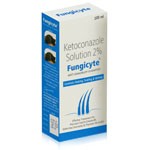Taming the Itch: Fungal Folliculitis Explained


Fungal folliculitis is a relatively common but often misdiagnosed skin condition. It occurs when fungal organisms, most frequently Malassezia species (a type of yeast found naturally on the skin), invade hair follicles and trigger inflammation. Because the symptoms can resemble bacterial infections or even acne, people frequently struggle with prolonged discomfort before receiving the right treatment. Understanding the clinical features, distinguishing fungal folliculitis from other conditions, and exploring treatment options — from topical antifungals to innovative therapies like Fungicyte — are essential steps toward proper management and relief.
Recognizing the Symptoms of Fungal Folliculitis
Fungal folliculitis typically presents as clusters of small, red, itchy bumps centered around hair follicles. Unlike bacterial folliculitis, the lesions often appear uniform in size, and they may be especially itchy rather than painful. Commonly affected areas include the chest, back, shoulders, arms, and sometimes the face.
In addition to redness and itchiness, the bumps may contain pus or resemble acneiform eruptions. Some people mistake them for ordinary pimples, but the persistence and widespread nature of the rash — combined with intense itching — are important clues that fungi, not bacteria, are involved. In chronic or severe cases, the rash may cover large body areas, causing embarrassment, discomfort, and reduced quality of life.
Distinguishing Between Fungal and Bacterial Folliculitis
One of the greatest challenges in managing folliculitis is telling whether the culprit is bacterial or fungal. Both conditions produce bumps, redness, and pustules, but the underlying organisms differ.
Bacterial folliculitis, most often caused by Staphylococcus aureus, tends to create pustules that are tender or sore, sometimes with a central hair shaft visible. These bumps may improve rapidly with antibacterial creams or oral antibiotics.
Fungal folliculitis, on the other hand, frequently resists antibiotic therapy. A key differentiating feature is that itching is more intense than pain. Another distinguishing sign is that fungal folliculitis often flares after antibiotic use, as antibiotics suppress bacterial populations and allow fungi to overgrow.
Dermatologists can confirm the diagnosis through a microscopic examination, culture, or biopsy. Skin scrapings viewed under a microscope may reveal yeast cells or fungal filaments. Because misdiagnosis delays effective treatment, anyone with persistent folliculitis that fails to improve on antibiotics should consider fungal involvement.
Approaches to Treating Fungal Folliculitis
The treatment strategy for fungal folliculitis depends on severity, extent, and underlying causes. In mild cases, topical antifungal creams or shampoos may suffice. These contain active agents such as ketoconazole, clotrimazole, or ciclopirox, which reduce yeast overgrowth and relieve inflammation. Applying them consistently for several weeks is usually necessary.
More widespread or resistant cases often require oral antifungal medications. Itraconazole and fluconazole are frequently prescribed. They work systemically, targeting yeast in the hair follicles from within. Although effective, oral antifungals must be used carefully because of potential side effects, drug interactions, and the risk of liver toxicity.
Equally important is addressing predisposing factors. Excessive sweating, hot and humid climates, tight clothing, and prolonged antibiotic use can all fuel fungal proliferation. Patients are advised to shower after heavy sweating, wear breathable fabrics, and avoid unnecessary antibiotics. For those prone to recurrent outbreaks, maintenance therapy with antifungal shampoos may help keep the condition under control.
Natural Approaches to Relief
While prescription medications remain the cornerstone of treatment, many patients ask whether natural remedies can help kill fungi and soothe folliculitis. Some plant-derived substances have antifungal activity, though their effectiveness is usually milder than pharmaceutical agents.
Tea tree oil, for example, possesses antifungal and antibacterial properties. When diluted properly and applied to affected areas, it may reduce fungal growth and inflammation. Aloe vera gel, with its soothing and antimicrobial effects, can help relieve itch and redness. Coconut oil, which contains lauric acid, has demonstrated mild antifungal activity and can also moisturize irritated skin.
Other lifestyle measures, such as maintaining good hygiene, reducing friction from clothing, and adopting a balanced diet that limits excessive sugar (which can promote yeast growth), may support the healing process. However, natural remedies should not replace medical antifungals in moderate or severe cases. They work best as complementary measures that provide comfort while professional treatment targets the root cause.
Choosing the Right Cream for Fungal Folliculitis
Topical antifungal creams are an important first line of defense. The most commonly recommended agents include ketoconazole, clotrimazole, and terbinafine. These medications interfere with fungal cell membrane formation, effectively killing or inhibiting yeast growth.
Ketoconazole cream is frequently prescribed because of its potency against Malassezia. It is applied directly to the affected areas, usually once or twice daily, and continued for several weeks. Clotrimazole and terbinafine are also effective and may be available over the counter in some countries.
Combination creams that contain both antifungal and mild corticosteroid ingredients can reduce inflammation and itching, though they should only be used under medical supervision to avoid side effects from prolonged steroid use.
For scalp involvement or widespread lesions, antifungal shampoos (e.g., ketoconazole 2% shampoo) can be used as a body wash two to three times per week, targeting fungal overgrowth while preventing recurrence.
Fungicyte and Its Role in Management
Among newer treatment options, Fungicyte has emerged as a promising therapy for fungal folliculitis. Fungicyte is designed to penetrate deeply into hair follicles, where fungal organisms reside, providing targeted antifungal action. Unlike some topical agents that remain mostly on the skin’s surface, Fungicyte’s formulation allows for better follicular delivery, enhancing its effectiveness against entrenched infections.
Patients using Fungicyte often report faster relief of itching and redness, along with more complete clearance of lesions. Its antifungal activity is paired with soothing properties that help restore skin balance. This makes it particularly useful for individuals who experience recurrent or treatment-resistant fungal folliculitis.
Another advantage of Fungicyte is its favorable safety profile compared to systemic antifungals. While oral medications can stress the liver and interact with other drugs, Fungicyte works topically with minimal systemic absorption. This makes it suitable for long-term management, either as a primary treatment or as a maintenance option after systemic therapy has achieved initial clearance.
As clinical experience grows, Fungicyte is increasingly being integrated into dermatologists’ treatment protocols. For patients who are frustrated with chronic, relapsing folliculitis, it provides a valuable alternative that combines potency, safety, and convenience.
Prevention and Long-Term Outlook
Fungal folliculitis, while uncomfortable, is generally manageable with proper treatment. However, recurrence is common if underlying risk factors are not addressed. Preventive measures play a crucial role. Regular use of antifungal body washes in predisposed individuals, maintaining a cool and dry environment for the skin, and avoiding unnecessary antibiotics all reduce the risk of flare-ups.
For athletes and people living in humid climates, showering promptly after sweating and wearing loose, breathable clothing can make a significant difference. Patients with recurrent folliculitis may also benefit from periodic prophylactic use of topical antifungals like Fungicyte or ketoconazole shampoo.
The long-term outlook is favorable when the condition is correctly diagnosed and treated. Unlike chronic bacterial infections, fungal folliculitis does not usually lead to scarring, though repeated scratching can cause hyperpigmentation or secondary bacterial infection. With careful attention to both medical and lifestyle interventions, most patients can achieve lasting relief.
Conclusion
Fungal folliculitis is a condition that often masquerades as bacterial infection or acne, delaying effective treatment. Recognizing its hallmark symptoms—itchy, uniform bumps centered on hair follicles—is the first step toward correct diagnosis. Differentiating fungal from bacterial folliculitis requires careful evaluation, sometimes supported by laboratory tests.
Treatment encompasses topical and systemic antifungals, complemented by natural remedies and preventive lifestyle measures. Antifungal creams such as ketoconazole remain highly effective, while new therapies like Fungicyte offer enhanced follicular penetration and long-term safety. With a combination of medical treatment, supportive care, and preventive strategies, fungal folliculitis can be successfully controlled, restoring comfort and confidence to those affected.
Drug Description Sources: U.S. National Library of Medicine, Drugs.com, WebMD, Mayo Clinic, RxList.
Reviewed and Referenced By:
Dr. Alan Carter, PharmD Clinical pharmacist specializing in infectious diseases and antifungal pharmacology. Frequently cited on Drugs.com for reviewing therapeutic guidance on ketoconazole, fluconazole, and itraconazole’s pharmacokinetics, dosage, and safety profile.
Dr. Carol DerSarkissian, MD Board-certified in internal medicine, contributor to WebMD. Her clinical reviews focus on dermatological infections, skin rashes, and the differentiation of fungal versus bacterial folliculitis. She provides expert validation on diagnostic and treatment strategies.
Dr. Dianne B. McKay, MD Professor of Clinical Pharmacology, contributor to RxList and NIH. Her medical insights address the renal and hepatic implications of long-term antifungal therapy, including the monitoring of systemic treatments like fluconazole and itraconazole.
Dr. William C. Shiel Jr., MD, FACP, FACR Chief Editor at MedicineNet, affiliated with WebMD. Authored comprehensive medical content on skin infections, folliculitis, and antifungal agents, including mechanisms of action, drug interactions, and known side effects.
(Updated at Sep 29 / 2025)

